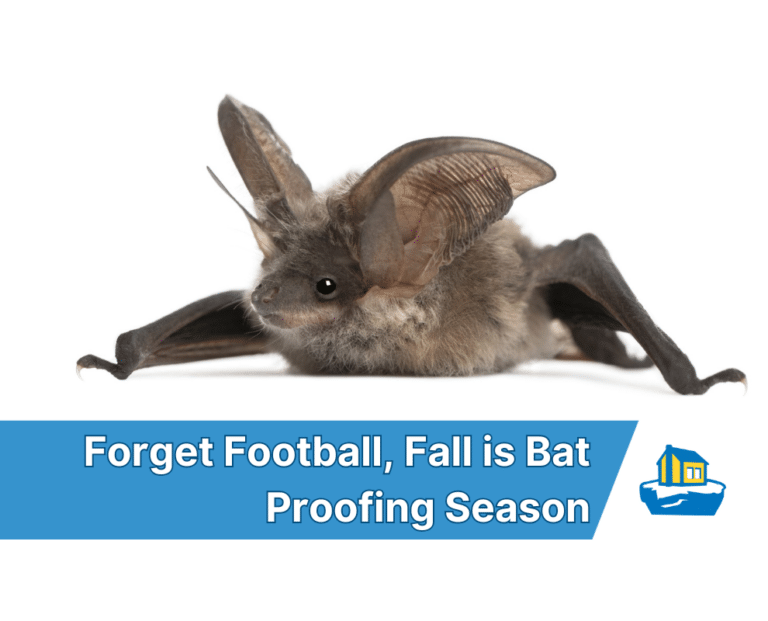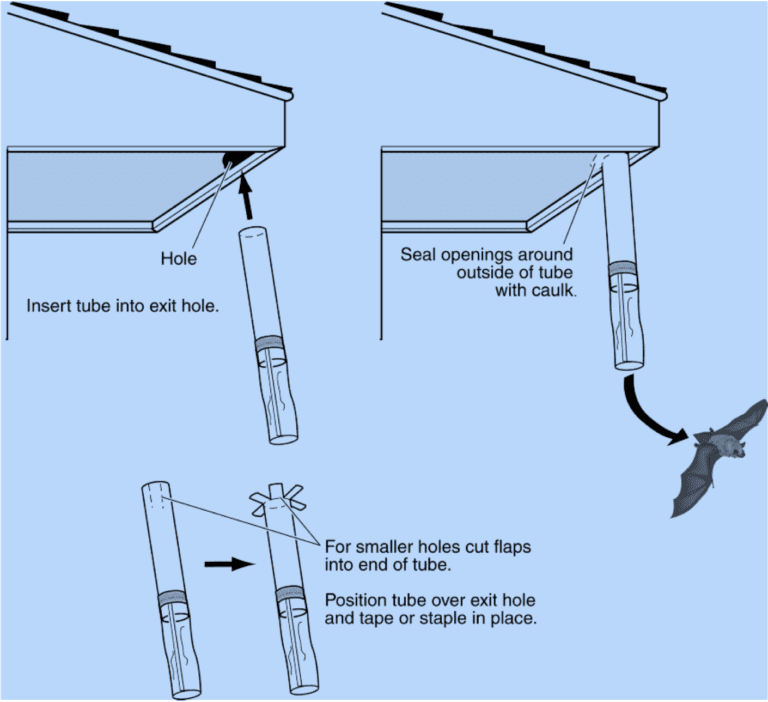4.8 1700+ Google Reviews

Early fall is the best season for bat-proofing your home as the maternity colonies have finished raising their young. So now, the babies are old enough to fly on their own and leave the roost. Plus, it is also prior to hibernation season for bats.
Bats are one of my favorite animals. Some bat species eat mosquitoes and who doesn’t appreciate that? In fact, some bats can eat up to 600 insects each night and I am all about it. While there are species of bats that eat nectar and pollinate plants, we do not have any here in Virginia.
Plus, we also have no vampire blood-sucking bats here in Virginia, so hooray for that.
All 15 bat species here in Virginia eat bugs and play an important role in our ecosystems. However, when the temperatures get colder, and there are fewer insects available for them to eat, they need to either migrate to warmer areas or hibernate.
There are cave bats and tree bats. Cave bats roost in caves, abandoned mines, inside tunnels, and under bridges. On the other hand, tree bats, you guessed it, roost in trees, logs, etc during the day. In either case, bats are nocturnal and do most of their eating at night. As a general rule, tree bats migrate to warmer areas as trees lose their leaves and become undesirable habitats, and cave bats hibernate.
Bats are true hibernators. They enter a torpor state where their bodily functions slow down greatly. In addition, their heart rate drops from about 300-400 beats per minute to 10-25 and they take breaths once every several minutes.
Unfortunately, the problem for our bat populations is that human disturbance of their hibernating locations has caused them to seek alternative places to hibernate. This includes residential homes, commercial properties, old buildings, and other urban areas that cause them to be a nuisance.
Bats generally hibernate from late fall through the winter months, so now is the time to start preparing to make sure your home does not end up being their winter home. Although I love bats, bat infestations inside a home are not good.
Bat guano (bat droppings) can carry fungal spores which cause histoplasmosis in humans. Histoplasmosis is a lung disease that can be fatal in people with compromised immune systems. Plus, bats can also have rabies which is a virus that can lead to death. Not to mention, bats have small teeth, and their bite marks can be hard to find, or disappear quickly.

First, let’s cover some things you shouldn’t do to prevent bats and should not be part of your bat-proofing strategy.
There are no effective bat deterrents on the market. Plus, not only are deterrents ineffective, most of them are illegal. So, do not waste your money. Also, don’t go to jail.
Virginia State Law 4VAC15-40-50 makes it illegal to poison any animal except mice and rats on your property. For example, throwing a bunch of mothballs in your attic to deter or eliminate bats is illegal. Please don’t do it.
Here in Virginia, we also have federal endangered species of bats, and it is a federal crime to harm them. Specifically, the Gray bat, Indiana Bat, and Virginia Big-Eared bat are endangered species. However, you shouldn’t hurt any bats, but if you harm an engendered bat, the criminal penalties are crushing.
Bats can fit into holes as small as 1/2″. Yes, that’s half an inch. To put that in perspective, that is smaller than a dime. So your first step is to inspect the outside of your home for any holes or openings a bat could fit through. Pay attention to penetrations through the siding, soffit, and fascia, intersections between materials, and roof-to-wall joints. These small openings are all potential bat entry points.
On the positive side, bats will not make their own holes. So sealing and repairing all entry points is your best defense against a bat problem.
Next, check your gable and ridge vents. The screens on your attic ventilation get damaged and can allow pests inside. Unfortunately, bats love to roost in gable vents. With this in mind, go into the attic and ensure all your vent openings’ screens are in good condition.
Don’t leave windows open that don’t have screens or have damaged screens. Bats can fly in through the windows. If you love fresh air and open windows make sure you have screens or repair any screen damage first.
Finally, keep in mind that bats sometimes roost in old chimneys. A chimney without a cap provides easy access for a colony of bats. So check your chimney for a cap and make sure it is in good condition.
Install a bat house. Installing a bat house, (or bat houses) on a nearby tree can attract local bats to the house as opposed to your house. Plus, hosting some bats around your house will really cut down on mosquitoes.

Bat proofing isn’t incredibly difficult, but since bats can fit into such small spaces, it’s not hard to miss some access points.
The most common bats you will find in your home here in Virginia are the big brown bat, and little brown bat. Remember, it is illegal to poison animals. You may be able to deal with individual bats on your own, but bat infestations should be left to professionals.
If you have one bat in your home, open you windows, put on a long sleeve shirt and leather gloves, and try to catch the bat or direct it outside. If the bat had any direct contact with you or especially young children, it is better to catch the bat if you’re able to do so safely, so it can be tested.
A colony of bats should be excluded by a pest control professional. Bat exclusions consist of installing one way devices to allow bats out, but will not allow them back in. However, this should not be done when there are baby bats present.
Baby bats rely on their parents for food. If the parents are excluded from the property, the young bats will starve and die. If they were in an area which is inaccessible, you may end up with dead bats decomposing in your home.
The bottom line is that bats are wild animals and pest control should be performed by trained professionals.
All those insects they eat end up in their poop. Check out this video where I show you exactly what bat poop looks like and tastes like ????
Bats are the only mammals that can sustain flight.
Guano (bat and bird droppings) is rich in nitrogen and phosphorus and was such a crucial fertilizer for farms, that wars were fought over guano and guano taxes.
A single little brown bat can eat up to 600 insects an hour.
White-nose syndrome has killed millions of bats since 2007. Experts say the populations of some species had been reduced by up to 90 percent in some states. Sadly, there is currently no cure.
The Virginia Big-eared bat is our official state bat.
Although bats are nocturnal, they mate all day and night and with many partners. And although mating occurs in the fall, female bats will delay fertilization until after hibernating.
Although, home inspectors are not required to inspect for, determine, or report on pest issues, most inspectors will report on any evidence of infestation observed. However, as discussed, bats may be roosting in areas not accessible, or visible to home inspectors such as behind siding, or in small crevices. Home inspectors are only required to inspect visible areas.
Bat proofing should be part of your fall home maintenance plan.
Although bats are amazing creatures, and incredibly beneficial to our ecosystem, a bat infestation in your home is hazardous to your health. It can be very expensive and to exclude bats and clean up their mess.
As always, if it is not a job you can tackle yourself, make sure you contact a professional.